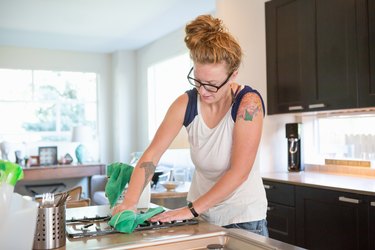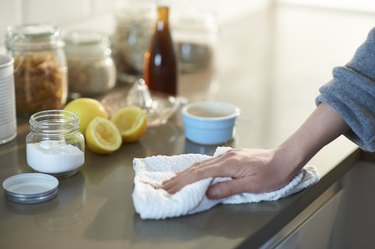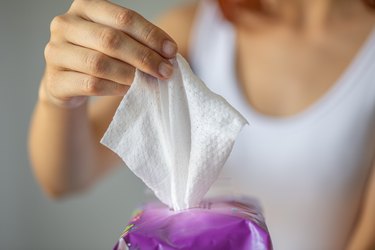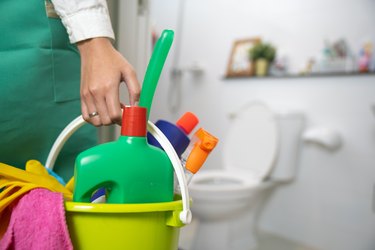
Quick: What's the first thing you think of when you hear air pollution? Probably a hazy, hazardous smog on the horizon, produced by power plants, industrial facilities and cars, right?
But studies show that the level of many air pollutants may be more than five times (and in certain cases, 100 times) higher indoors, according to the Agency for Toxic Substances and Disease Registry (ATSDR).
Video of the Day
Video of the Day
That's a big problem for your pulmonary health, because more than 80 percent of your time is spent inside, says pulmonologist Panagis Galiatsatos, MD, MHS, director of the Tobacco Treatment Clinic at Johns Hopkins Bayview Medical Center.
"If you're indoor air quality isn't good, you're not going to be breathing well," Dr. Galiatsatos says.
Indeed, poor indoor air quality can cause or contribute to the development of infections, lung cancer and chronic lung diseases like asthma, according to the American Lung Association (ALA).
While air filters can effectively eliminate indoor air pollutants, they can also cost a pretty penny. Luckily, they're not your only option when it comes to optimizing indoor air.
Here, Dr. Galiatsatos shares nine simple strategies to improve indoor air quality without an expensive air purifier.
Tip
There are many possible sources of indoor air pollution. Some indoor contaminants include the following, per the ATSDR:
- Asbestos
- Biologic agents (animal dander, bacteria, cockroaches, dust mites, mildew, molds, pollen and viruses)
- Building materials
- Radon (released when uranium in the soil or rock — on which homes are built — breaks down)
- Tobacco smoke
- Wood stoves, gas ranges or other heating devices
1. Quit Smoking
"The number one contributor, still to date, of bad indoor air quality is smoking," Dr. Galiatsatos says.
While we all know puffing poses significant health hazards to smokers, secondhand smoke, which degrades indoor air quality, puts nonsmokers at risk for lung-related illness too.
That's because secondhand smoke contains toxic and carcinogenic chemicals including formaldehyde, benzene, vinyl chloride, arsenic ammonia and hydrogen cyanide, according to the ALA.
Even smoking outdoors doesn't solve the indoor air quality problem, because people can still carry residual thirdhand smoke inside the house, Dr. Galiatsatos says. Thirdhand smoke can stick to surfaces for weeks to months and re-enter the air, per the ALA.
If you want to kick the habit (or help someone else quit), the ALA's Freedom From Smoking program is a good place to start.
2. Clean and Maintain Gas and Wood Stoves
"As a lung doctor, I ask patients, 'how do you cook your meals?'" Dr. Galiatsatos says.
That's because wood and gas stoves can emit harmful fumes, that, when breathed in over time, can lead to lung-related illnesses. "When people hear of a lung disease like COPD, the whole world reflexively thinks, smoking, but the second cause of it is this — how you cook," he says.
Indeed, more than half of American households cook with gas ranges, which can release respiratory irritants like nitrogen oxide, according to the ATSDR.
And research demonstrates that children living in homes with wood stoves — which can emit carbon monoxide, oxides of nitrogen, particulates and hydrocarbons — have a greater risk for respiratory symptoms, per the ATSDR.
That doesn't mean you can't safely use gas or wood stoves, Dr. Galiatsatos says. You just need to make sure they're well cleaned and maintained.
Check with the manufacturer for proper care instructions. Following these directions for cleaning and maintenance can ensure that your cooking method isn't meddling with your indoor air quality.
3. Improve Ventilation
If you have a plethora of indoor pollutants, opening windows and doors might help flush them out.
Proper ventilation helps to lower levels of indoor contaminants, thus improving indoor air quality, according to the Environmental Protection Agency (EPA).
However, before you crack open the windows, carefully evaluate your surroundings. "I have a patient who lives behind a massive bus station, so if they open the windows, they'll get all the automobile fumes," Dr. Galiatsatos says.
In other words, be smart: If the air quality isn't good outside, don't let it indoors.
4. Clean Your Home Often
From dead skin cells to dirt from outdoors, dust is an unpleasant potpourri of particles circulating around the air inside your home. "And if dust is on the floor or your countertops, it's getting breathed into your lungs," Dr. Galiatsatos says.
Fortunately, frequent dusting and vacuuming can substantially improve indoor air quality. "Keeping a hygienic house goes a long way toward being able to breathe well," Dr. Galiatsatos says.
5. Use Nontoxic Household Cleaning Products
In your quest to keep your indoor space spotless and dust-free, pay attention to the cleaning products you use to prevent harm to your pulmonary health.
Certain cleaning agents are terribly toxic and can irritate your lungs, Dr. Galiatsatos says. Sometimes just the scent of a cleaning solvent can aggravate a person's nostrils or cause shortness of breath, he says.
While potent disinfectants are necessary to sanitize hospital settings, you don't need this caliber of chemicals to clean your home. There's a huge distinction between disinfecting and cleaning, and unless someone in your home is sick and actively spreading germs, you don't really need to do the former, Dr. Galiatsatos explains.
The takeaway: Stick to safer, less-hazardous cleaning agents. And if you must use strong disinfectants or aerosols in your home, Dr. Galiatsatos recommends wearing a face mask while cleaning and then letting the space air out for a few hours.
6. Control Pests
Not only are pests a pesky inconvenience, but they can also impair your pulmonary health too.
"If you're finding pests in the home — mice, roaches and so forth — they're going to leave their own dust-like remnants behind that you'll be breathing in," Dr. Galiatsatos says.
For instance, cockroaches produce allergens that can become airborne and exacerbate conditions like asthma, according to the ALA.
"Actually, what we've found, especially in children, is a lot of out-of-control asthma problems occur in homes where pests are present," Dr. Galiatsatos says.
To control (and prevent) pests, keep food sealed and off the floor, cover trash and dispose of garbage regularly, clean your home frequently and, if necessary, use pest baits.
7. Keep a Cap on Humidity
Humidity can hamper indoor air quality in several ways. For one, "water vapor clusters like a magnet, pooling all the dust [in a room] together," Dr. Galiatsatos says. "So when you inhale the air, it's like you're breathing in dust balls."
What's more, high humidity promotes the growth of mold and other pollutants that can contaminate the air in your home, Dr. Galiatsatos says.
All this to say, a cool, dry environment is better for indoor air quality. You should aim to maintain humidity levels under 50 percent, per the ALA. Simple strategies — like using a dehumidifier or air conditioner — can make a huge difference when it comes to decreasing humidity.
8. Don't Use Scented Candles or Fragrances
While scented candles and fragrances may add an appealing aroma to your home, they might also be interfering with indoor air quality.
For starters, some people can't tolerate certain fragrances, and their lungs may experience the scent as an irritant, Dr. Galiatsatos says. The telltale sign is if a fragrance makes you cough, sneeze or feel short of breath.
Secondly, scented candles involve combustion, which, in and of it itself, can contribute to poor air quality. "Fire is still fire, regardless of whether it makes the air smell good or not," Dr. Galiatsatos says.
That's because the smoke particles created through combustion (i.e., lighting the candle) affect the lungs. In fact, it's no different than breathing in secondhand smoke, Dr. Galiatsatos says. And over time, with constant exposure, lighting scented candles can even contribute to more insidious conditions like COPD, he adds.
Instead of using scented candles or fragrances to mask odors, find the source of the stink in your home (like an overflowing trash can, for instance) and deal with it directly, per the ALA.
9. Keep Pets Out of Your Bedroom
Your beloved pets could be the cause of pulmonary problems too.
Pets produce dander (flecks of dead skin) and additional allergens that can linger in the air for a long time, according to the ALA. And when a person with a pet allergy breathes in this pet-polluted air, they can experience worsened respiratory symptoms and decreased lung function, per the ALA.
This doesn't mean you should get rid of your pets, but if they're aggravating your allergies, try to keep them out of the rooms where you're spending most of your time (like your bedroom), Dr. Galiatsatos says.
In addition, don't allow your animals on furniture or carpets (where dander and dust can stick), and clean your home often, per the ALA.
What About House Plants?
You've probably heard that house plants can help prevent indoor air pollution. But before you buy a bunch of new blooms, you should know this claim is mostly bogus.
For the record, there's currently no significant evidence that house plants eliminate indoor pollutants in homes and offices, according to the EPA.
Dr. Galiatsatos agrees: "If people put all the stock into house plants without doing the other things, it won't help indoor air quality."
In fact, indoor house plants can be part of the pollution problem if you over-water them. Watering plants too much can make excessively damp soil a fertile ground (literally) for microorganisms that can act as allergens, per the EPA.
A Final Word on Air Filters
While air filters can be expensive, they are one of the best methods available to ensure good indoor air quality. If you want to purchase a HEPA filter, you can buy one on a budget, Dr. Galiatsatos says.
"Keep in mind you don't have to buy one for the entire house," he adds. If you know you're going to spend most of your time in the office, for example, you can buy a relatively small filter for that area.
"It can make a world of difference," Dr. Galiatsatos says, "especially for a room like your bedroom where you know you'll spend at least eight hours a day."
- American Lung Association: “Indoor Air Pollutants and Health”
- American Lung Association: “Health Effects of Secondhand Smoke”
- Agency for Toxic Substances and Disease Registry: “What Are Possible Sources of Indoor Air Pollution?”
- Environmental Protection Agency: “Improving Indoor Air Quality”
- American Lung Association: “Why Are Cockroaches an Indoor Air Problem?”
- American Lung Association: “Keep Sources of Pollution Out of Your Home”
- American Lung Association: “Pet Dander”
Is this an emergency? If you are experiencing serious medical symptoms, please see the National Library of Medicine’s list of signs you need emergency medical attention or call 911.


